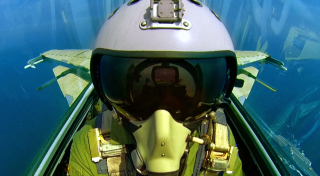China Might Have Stealth Fighters, But How Good are the Pilots Who Fly Them?
That seems to be a problem--until now.
China has the third largest air force in the world and may surpass the United States within the next 15 years. But in an aerial shooting war with the U.S. Air Force, Beijing will need more than aircraft — also fighter pilots with well-honed skills capable of facing off with some of the best jocks in the world.
(This article by Robert Beckhusen originally appeared at War is Boring in 2016.)
Right now, Chinese pilots struggle. Underdeveloped tactics and training regimens which discourage initiative — among other problems — means that, as a whole, China’s top guns are less proficient than they could be.
The People’s Liberation Army Air Force is also well aware of this, and is changing the way it trains pilots, according to a recent report by the RAND Corporation, a think tank with close ties to the U.S. Air Force. These changes, over time, could do much to reduce the skill gap between the Chinese and American air forces.
China’s air force doesn’t match the United States, because for most of recent history, it didn’t need to.
The traumatic experience of World War II, when 14 million Chinese lost their lives in a Japanese invasion and occupation, shaped Chinese strategy to favor large ground forces. For much of the Cold War, Beijing’s leaders viewed the risk of another invasion, particularly from the Soviet Union, as their number one military threat.
To be sure, China has undertaken major military reforms since the 1980s aimed at extending presence into the South and East China Seas, thereby forcing the naval and air forces of an opponent — namely the United States — to operate from farther away. China is also shrinking its army but expanding its air force and navy, and rethinking how to fight war on different terms.
But the PLA’s highly centralized, top-down structure remains in place and stifles the skills of its fighter jocks. Unrealistic plans and by-the-book training regimens don’t translate well in combat, when those plans can be blown away the moment they meet enemy contact.
Training pilots to adapt to changing conditions — and to make decisions on the spot — “remains new to many pilots accustomed to having most, if not all, of their tactical maneuvers dictated to them by PLAAF unit commanders in the control tower,” the report stated.
Take, for instance, the most important aircraft in a fighter formation — the lead plane. Basically, the plane in front, manned by an experienced pilot responsible for commanding the formation and (usually) leading dogfights.
Chinese lead pilots often lack tactical skills, aerial maneuvers and changing flight plans without instructions from the ground. To make matters worse, they often defer to “ground command and guidance personnel during confrontations,” the RAND report quoted the Chinese air force newspaper Kongjun Bao.
“As such, there were many unfavorable factors that come about during air combat [training]. For example, ground commands often are not able to keep up with the complex and changeable air situation,” Kongjun Bao added.
“Pilots relied too much on the commands and guidance from the ground, which was not conducive to enhancing the enthusiasm and initiative of airborne combatants.”
The same problems crop up during mock attacks on ground targets. In one exercise, commanders tested pilots by changing their targets on an “ad-hoc” basis, but the nervous aviators choked, flew too low and missed.
Of course, the reason we know this is because China is deliberately pushing its pilots into unfamiliar territory and, in PLAAF terminology, forcing them to “fight and win” in “actual combat conditions.”
Details are few, but RAND notes that the Chinese air force is making its pilots develop their own flight plans while giving them “full autonomy over their sorties, from starting their engines to changing navigation routes and flying tactics in the air,” RAND noted.
Beijing is even shuffling pilots between different air bases to mix up the terrain. During mock air battles, commanders have restricted the amount of information shared between formations before they wage simulated duels.
The PLAAF will even “frequently remove safety restrictions,” the report added.
But even better pilots might not matter much, in the end. Beijing anticipates a potential conflict with the United States to take place in the Western Pacific, where China enjoys a numerical advantage.
Over Taiwan, that advantage could be 3:1 just in aircraft, according to a separate RAND study published in 2008. The odds get even worse for the Pentagon if China can successfully knock out America’s nearest air bases, such as Kadena in Japan, with an onslaught of ballistic missiles.
Now fast forward to 2030, and combine those numbers with fighter pilots schooled for more than a decade in dogfighting … the right way.
Image: PLAAF Photo

